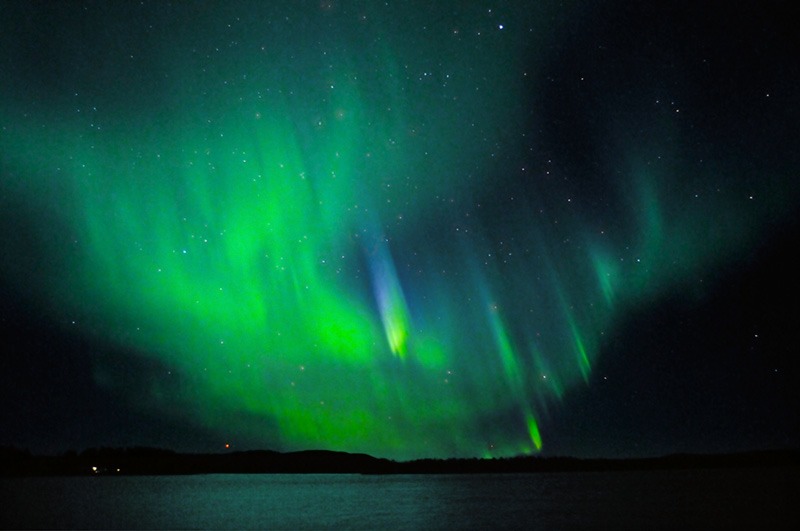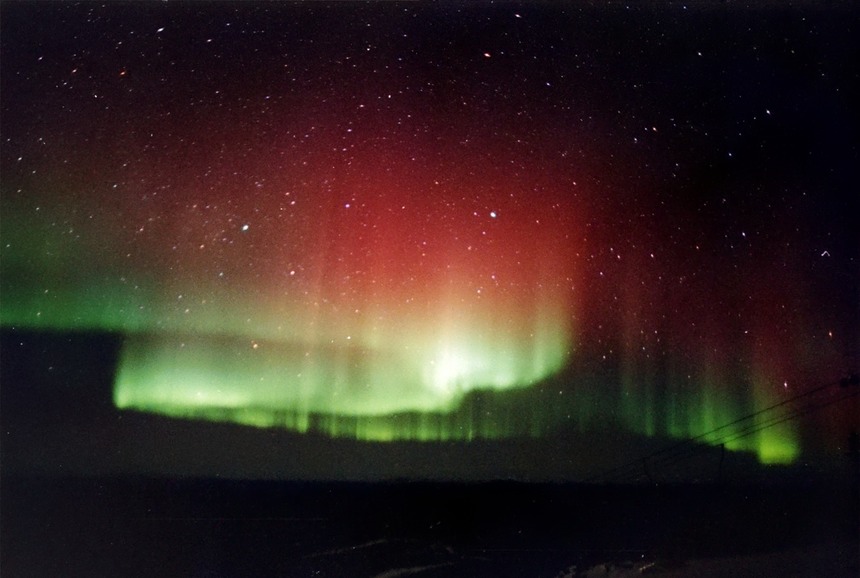In a general sense, auroras (pl: Aurorae) are natural atmospheric plasmas around a planetary body that typically have magnetic fields.

Northern Lights with very rare blue light emitted by nitrogen. image: Varjisakka/wikipedia
Auroras on Earth are natural light displays in the sky (from the Latin word aurora, "sunrise" or the Roman goddess of dawn), predominantly seen in the high latitude (Arctic (Borealis) and Antarctic (Australis) regions.
Aurorae are caused by cosmic rays, solar wind and magnetospheric plasma interacting with the upper atmosphere (thermosphere/exosphere).
Charged particles, mainly electrons and protons, enter the atmosphere from above causing ionization and excitation of atmospheric constituents ( different gases such as nitrogen oxygen, and produce light emissions. Similar to a toy plasma ball.

A red auroras seen from Alaska . image: Brocken Inaglory/wikipedia
Auroras caused by protons are sometimes referred to as proton arcs. Incidental protons can also produce emissions as hydrogen atoms after gaining an electron from the atmosphere.
Where do the different types and colours of auroras come from?
Auroras take many different visual forms.
Discrete auroras
These are the most distinctive and brightest being curtain-like auroral arcs. They eventually fragment or ‘break-up’ into separate, and rapidly changing, often rayed features that may fill the whole sky.
These are at times bright enough to read a newspaper by at night.
Diffuse auroras
The ‘diffuse’ aurora, on the other hand, is a relatively featureless glow sometimes close to the limit of visibility. It can be distinguished from moonlit clouds by the fact that stars can be seen undiminished through the glow.
These are often composed of patches whose brightness exhibits regular or near-regular pulsations. The pulsation period can be typically many seconds, so is not always obvious. Occasionally there is a fast, sub-second, flickering. A typical auroral display consists of these forms appearing in the above order throughout the night.
Colours include:
Red: At the highest altitudes, excited atomic oxygen emits at 630.0 nm (red); low concentration of atoms and lower sensitivity of eyes at this wavelength make this color visible only under more intense solar activity. The low amount of oxygen atoms and their gradually diminishing concentration is responsible for the faint appearance of the top parts of the "curtains". Scarlet, crimson, and carmine are the most often-seen hues of red for the aurorae.
Green: At lower altitudes the more frequent collisions suppress the 630.0 nm (red) mode: rather the 557.7 nm emission (green) dominates. Fairly high concentration of atomic oxygen and higher eye sensitivity in green make green auroras the most common. The excited molecular nitrogen (atomic nitrogen being rare due to high stability of the N2 molecule) plays its role here as well, as it can transfer energy by collision to an oxygen atom, which then radiates it away at the green wavelength. (Red and green can also mix together to produce pink or yellow hues.) The rapid decrease of concentration of atomic oxygen below about 100 km is responsible for the abrupt-looking end of the lower edges of the curtains.
Yellow and pink are a mix of red and green or blue. Other shades of red as well as orange may be seen on rare occasions; yellow-green is moderately common. As red, green, and blue are the primary colours of additive synthesis of colours, in theory practically any colour might be possible but the ones mentioned in this article comprise a virtually exhaustive list.
Blue: At yet lower altitudes, atomic oxygen is uncommon, and ionized molecular nitrogen takes over in producing visible light emission; it radiates at a large number of wavelengths in both red and blue parts of the spectrum, with 428 nm (blue) being dominant. Blue and purple emissions, typically at the lower edges of the "curtains", show up at the highest levels of solar activity.[23]
Ultraviolet: Ultraviolet light from aurorae (within the optical window but not visible to virtually all humans) has been observed with the requisite equipment, and otherwise invisible aurorae of this type were produced on a very small scale by certain HAARP experiments. Ultraviolet aurorae have also been seen on Mars.
Infrared: Infrared light, in wavelengths that are within the optical window, is also part of many aurorae.
Adapted from: Aurora. (2015, August 16). In Wikipedia, The Free Encyclopedia. Retrieved 05:42, May 29, 2017, from https://en.wikipedia.org/w/index.php?title=Aurora&oldid=676405025